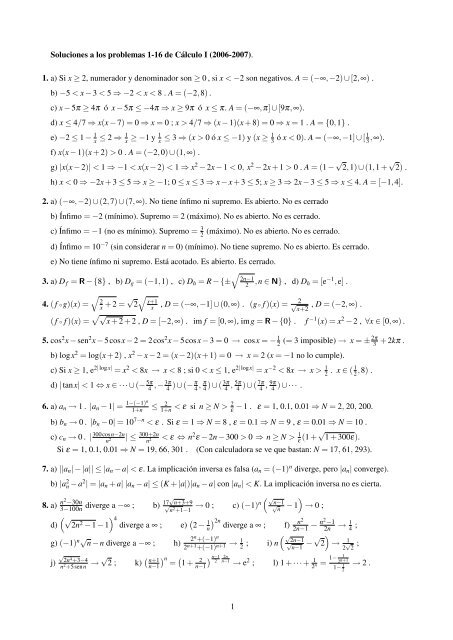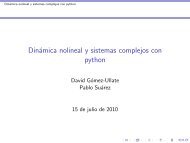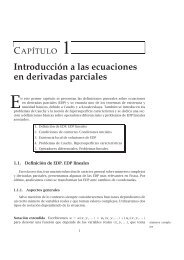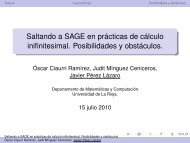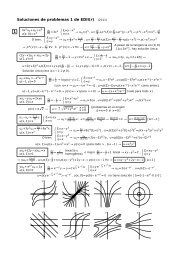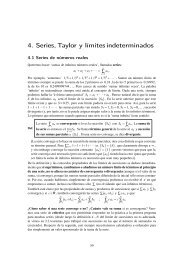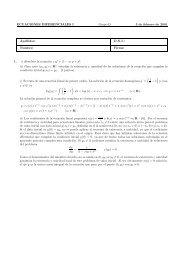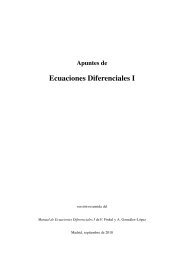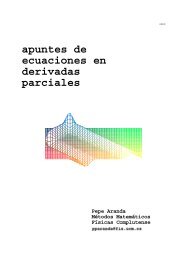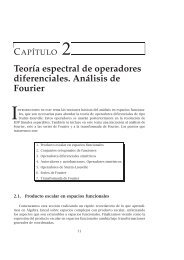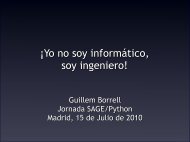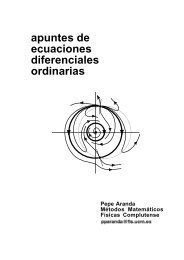1. a) Si x ⥠2, numerador y denominador son ⥠0 , si x < â2
1. a) Si x ⥠2, numerador y denominador son ⥠0 , si x < â2
1. a) Si x ⥠2, numerador y denominador son ⥠0 , si x < â2
- No tags were found...
You also want an ePaper? Increase the reach of your titles
YUMPU automatically turns print PDFs into web optimized ePapers that Google loves.
Soluciones a los problemas 17-42 de Cálculo I (2006-2007).17. a) f ′ (x) = 3x 2 sen 1 x − xcos 1 x , f ′ (0) = 0. f ′′ (x) = 6xsen 1 x − 4cos 1 x − 1 x sen 1 x, en R − {0}.b) g ′ (x) = 1+log|x| , en R − {0}. g ′′ (x) = 1 x, en R − {0}.c) h ′ 2(x) =x[1+4(log|x|) 2 ] , en R − {0}. h′′ (x) = − 2[1+8log|x|+4(log|x|)2 ]x 2 [1+4(log|x|) 2 ] 2 , en R − {0}.{ 73d) k ′ x(x) =4/3 {− 2x <strong>si</strong> x > 1282x − 7 3 x4/3 <strong>si</strong> x < 1 . k′′ (x) = 9x 1/3 − 2 <strong>si</strong> x > 12 − 28 9 x1/3 <strong>si</strong> x < 1 .e) l ′ (x) = −2x(1−x 2 ) √ , en (− √11−2x2 2, √ 1 2) . l ′′ 8x(x) =4 −2x 2 −2(1−x 2 ) 2 (1−2x 2 3/2, en (− √1) 2, √ 12) .f) m ′ (x) = (5x 2 +2x+1)(3x+1) −4/3 en R − {− 1 3 }. m′′ (x) = 2(5x 2 +4x−1)(3x+1) −7/3 en R − {− 1 3 }.18. Por continuidad: a+b = 1 . Por derivabilidad: −1 = 2b . a = 3 2 , b = − 1 2 .19. La ecuación de la recta tangente a f(x) en x = a es y = e a2 −a [(2a − 1)(x − a)+1] , que pasa porel origen <strong>si</strong>: 2a 2 − a − 1 = 0 ⇒ a = − 1 2 , 1 . Por tanto, los puntos pedidos <strong>son</strong>: ( − 1 2 , e3/4) y (1,1) .√20. Buscamos x ∈ (0,1) con f ′ 1(x) =x 2 −2x+2 = π 4(pendiente de la recta). x = 1 − 4π− 1 lo cumple.[Que existía un c con esa pendiente se podría deducir del teorema del valor medio].{ −1+4/x, x ∈ (0,4]2<strong>1.</strong> g(x) =1 − 4/x, x ∈ (−∞,0) ∪[4,∞){ −4/xg ′ (x) =2 , x ∈ (0,4)4/x 2 , x ∈ (−∞,0) ∪(4,∞)431Rectas tangentes: y = x+5, y = −x+3 . Corte: (−1,4) .-2 0 2 422. Derivando implícitamente: y ′ (x) = − 2xy1+x 2 +3y 2 → y ′ (2) = − 1 2 . La recta tangente es: y = 2 − x 2 .[La y no se puede despejar, pero sí se podría despejar la x ].23. f ′ (0 + ) = 2, f ′ (0 − ) = 0 ⇒ no es derivable en x = 0 . f ′ (x) ≠ 0 en [− 1 2 , 1 4 ] − {0} .f decrece en (− 1 2 ,0) y crece en (0, 1 4 ) ⇒ x = 0 es el mínimo. f(− 1 2 ) < f( 1 4 ) ⇒ máximo en x = 1 4 .24. f ′ (x) = 0 ⇒ x = 1 2 . f(1) = π 2 , f(−1) = − π 2 + √ 3log3 . Máximo en 1 y mínimo en −<strong>1.</strong>25. a) f(−8) = −52, f(64) = −16, f(0) = 0, f ′ (27) = 0, f(27) = −27. Mínimo en −8 y máximo en 0.b) g(0) = 2, g(π) = π + 2, g( π 2 ) = π 2 . g′ ( π 6 ) = 0, g( π 6 ) = π 6 + √ 3 . Mínimo en π 2c) h ′ (x) = 0 ⇔ x = 4 . Valor mínimo: h(4) = 7 √ 2 . El valor máximo no existe.-1y máximo en π .26. f ′ (x) = 1 − 2senx → en x = π 6valor máximo. El valor mínimo será f(0) = 2 < f(1) = 1+2cos1 ,pues cos1 > cos π 3 = 1 2 (o porque, como veremos, cos1 = 1 − 1 2 + ··· > 1 2, serie de Leibniz).f ′ (x) ≥ 1 − 2sen 1 2 > 0 <strong>si</strong> x ∈ [− 1 2 , 1 2 ] ⇒ existe f −1 . Como f −1 (2)=0 (es f(0)=2): ( f −1 ) ′ (2) = 1f ′ (0) = 1 .27. f ′ (x) = chx e shx + 1 > 0 ∀x ⇒ f es estrictamente creciente en todo R ⇒ existe su inversa.Al ser f derivable, f −1 también lo es y se tiene que: ( f −1 ) ′ (1) =1f ′ ( f −1 (1))=f(0)=11f ′ (0) = 1 2 .3
28. f( π 2 ) = e − π Bolzano2− 1 > 0 , f(π) = −π < 0 y f continua ⇒ se anula al menos una vez.Como además f ′ (x) = cosxe senx −1 < 0 en ( π 2,π) ( cosx es negativo y la exponencial es po<strong>si</strong>tiva),f es estrictamente decreciente en [ π 2,π] y, por tanto, se anula exactamente una vez.29. f ′ (x) = x(2−x2 )(1−x 2 ) 3/2 ⇒ f decrece en (−1,0] y crece en [0,1). f( 3 5 ) = 920 < 2 3 < f( 4 5 ) = 1615 y f continuaen [ 3 5 , 4 5 ] ⇒ ∃c ∈ ( 3 5 , 4 5 ) con f(c) = 2 3. Al ser f creciente en el intervalo, el c es único.30. f ′ (x)= − x2 −3x+13x(1+x 2 ) = −(x−x −)(x−x + )3x(1+x 2 , con x)± = 3±√ 52. 2 < √ 5 < 3 ⇒ x − ∈ (0, 1 2 ) , x + ∈ ( 5 2 ,3) .f x→0+ → ∞ , f decrece en (0,x − ] , f(x − )>0 [ arctanx,−logx > 0 en (0,1)],f(1) = π 4 , f crece en [x −,x + ] y decrece en [x + ,∞) , f x→∞ → −∞ ⇒la continua f corta una única vez el eje x en un c > x + de (0,∞) .f estrictamente decreciente en [3,∞) ⇒ es inyectiva en el intervalo.x3<strong>1.</strong> 2 +1límx→±∞ e x2 −3x∞/∞= límx→±∞2x 12x−3 e x2 −3x = 0 . f ′ (x) = (3+3x 2 −2x 3 )e 3x−x2 .f ′ =0 ⇔ P(x) = 3+3x 2 −2x 3 = 0 .P ′ (x)=6x(x−1) → P crece en [0,1] y decreceen el resto; P(0)=3 , P(1)=4 , P(2)=−1⇒ P se anula sólo en el c ∈ (1,2) .fx – 1 x +f ′ (1)=4e 2f ′ (2)=−e 2 Bolzano⇒ f ′ =0 en algún c∈(1,2) .Con f(0)=1 y los cálculos anteriores, la gráfica de f es más o menos ր . f(x) = 1 exactamente en 2 puntos.332. La gráfica muestra que claramente tiene 1 solución <strong>si</strong> a < 0 y ninguna <strong>si</strong> a = 0 .Vemos de varias formas que <strong>si</strong> 0 < a < e no hay ninguna, 1 <strong>si</strong> a = e y 2 <strong>si</strong> a > e :Habrá 1 <strong>si</strong> ax y e x <strong>son</strong> tangentes, es decir, para el b tal que la recta tangentey = e b + e b (x − b) pase por (0,0) → b = 1 → a = e .O bien: g(x) = e x − ax , g ′ (x) = e x − a → decrece hasta x=loga y luego crece.El valor mímimo g(loga) = a(1−loga) es >,=,< 0 según a e .O bien, dibujando la gráfica de h(x) = xe −x y viendo cuántas veces corta y = 1 a .e11a=e34.prob 34aa = 0,–1,–2,–3prob 34b1-1 1a04
33.a)2–21–3 3b)1 6–221–3c)1 6–22–131–3g)11h)1–1–12–2e)1–1/2–/2d)1–1 2–21–1/2–/2–/2/2f)332120-11-2-3-1-2-3–ln25
35. Mínimos en ( ± 1 2 ,±1 2). Máximos en (±1,0), (0,±1).136. Rectas por (1,2): y = 2+m(x − 1). Hay que minimizarA(m) = 1 2 (1 − 2 m)(2 − m), con m ∈ (−∞,0).Área mínima <strong>si</strong> m = −2 (x = 2, y = 4).No existe el de área máxima.42prob 361prob 372437. Recta tangente y = x−4 √3. Distancia al cuadrado:D(x) = (x−2) 2 +( x−4 √3) 2 mínima <strong>si</strong> x = 5 2 → y = − √32 .[O bien, el punto más próximo pertenece también a la perpendicular que pasa por (2,0) : y = − √ 3(x−2) ].√38. 3y 2 = 21+20x − x 4 → y = ±21+20x−x 43. Definida <strong>si</strong> x ∈ [−1,3].y ′ = 0 → x = 3 √5 ≈ <strong>1.</strong>71 . y(3√5) ≈ ±3.94 . y(2) = ±√15 .Máximos y mínimos de: D(x) ≡ (d[(x,y),(0,0)]) 2 = − 1 3 x4 + x 2 + 203 x+7 .D ′ (x) = 0 → x = 2, D(2) = 19. D(−1) = 1, D(3) = 9.Mínimo de D <strong>si</strong> x=−1 [punto (−1,0) ] y máximo <strong>si</strong> x=2 [puntos (2,± √ 15) ].39. Función a minimizar: D(x) = |x|+|2arctan(x − 2)|.Es claro que el mínimo se da en [0,2] → D ′ = (x−1)(x−3)1+(x−2) 2 = 0 <strong>si</strong> x = 1 .D(1) máximo local. Además: D(0) = 2arctan2 > 2 = D(2) ,pues arctan2 > arctan √ 3 = π 3> 1 . Punto más cercano: (2,0) .2–1 2 322arctan(x-2)40. Área del rectángulo: A(x) = x f(x) = √ x . x 3 +4 A′ (x) =8−x3 ⇒ x = 2 máximo local. A2(x 3 +4) 3/2 max = √ 1 3.4<strong>1.</strong> Área del triángulo limitado por la tangente en x = a: A(a) = 1 2 e−a (1+a) 2 . Es máxima <strong>si</strong> a = <strong>1.</strong>42. Distancia AP = 100cosθ . Distancia PB = 100θ . Tiempo empleado: T(θ) = 2cosθ + θ .Mínimo <strong>si</strong> θ = π/2 (P = A , no debe tirarse al agua).f(x)A(x)prob 40e —a(a+1)prob 41P (a,e—a)PBxaa+1prob 42A6
Soluciones a los problemas 43-69 de Cálculo I (2006-2007).43. {a n } acotada inferiormente por 0 (los a n <strong>son</strong> po<strong>si</strong>tivos) y decreciente (pues n+23n+1< 1 ⇔ 2n > 1)⇒ ∃líma n = a ⇒ a = a 3 ⇒ a = 0. Como |a n+1||a n |→ 1 3 < 1 la serie converge (y confirma a n → 0).44. a) (a n ) 1/n = 2nn → ∞. Divergente. (O porque {a n} ↛ 0).b) 3+cosn √ n≥ 2 √ n. Divergente.c) Geométrica. | − π e−100e| > 1 ⇒ Divergente. d) ∑ ndiverge, ∑ e−n100converge ⇒ Divergente.e) (n+1)e−(n+1)2= n+1ne −n2 ne−2n−1 → 0 ó n 1/n e −n → 0 ⇒ Convergente.f) | a n+1a n| = 2 n+1n 2 → 0 ⇒ Convergente. g) 2+(−1)nn 2 +3≤ 3n 2 +3 , de igual convergencia que ∑ 1 n 2 ⇒ Convergente.h) n+2425n → 125 ⇒ a n no tiende a 0 ⇒ Divergente. i) ( nn+2 )n → e −2 ⇒ Divergente.j)1/n→ 0 y1/(logn)∑ 1 2 ndivergente ⇒ Divergente. k)∫ ∞2dxx(logx) 2 < ∞ ⇒ Convergente.l) 4n−1n(n−1) → 0 y decreciente ⇒ Convergente. m) tan 1 n ∼ 1 tanxn, porquex→ 1 yx→0n) |a n+1||a n |= (n+1)!(n+1)! (2n)!n!n! (2n+2)! =(n+1)2(2n+2)(2n+1) = n+12(2n+1) = 1+ 1 n4+ n21→n→∞ 4 < 1 ⇒ Convergente.ñ) |senn √n 3 +cos 3 n | ≤ 1 √n 3 −1 , 1/√ n 3 −11/n 3/2 → 1 y ∑ 1n 3/2 convergente ⇒ Converge (absolutamente).o)1 √ n−1− 1 √ n+1=2√n 2 −1( √ n−1+ √ n+1) . Convergente.1 n → 0 ⇒ Divergente.45. a) 18∞∑n=2( 2) n+∞3 9 ∑n=2( )−1 n3 =994 . b) ∑∞ ( )1√n− √ 1n+1= 1 .n=146. a) c > 0 (Leibniz). b) ∑ 2e n cn+nconverge ⇒ la dada converge <strong>si</strong> lo hace ∑ e n +n ⇔ |c| < e .(n+1)c) Cociente:c(3n+3)(3n+2)(3n+1) → r < 1 ⇔ c ≤ 3 . d) Geométrica: ∣ c−1∣ 4< 1 ⇔ −3 < c < 5 .e) | a n+1a n| = n+1n+2 |2c − 1|2n+1 ⇒ converge <strong>si</strong> |2c − 1| < 1; <strong>si</strong> c = 1 diverge y <strong>si</strong> c = 0 converge; 0 ≤ c < <strong>1.</strong>47.f) | a n+1a n| = 2|c|n+1→ 0 ∀c ⇒ converge ∀c ∈ R .∞2∑n−2a= 1 n 4n=2∞∑ ( 2 a )n = 1 4n=24/a 21−2/a = 1a(a−2) , <strong>si</strong> la serie geométrica converge ⇔ | 2 a | < 1 ⇔ |a| > 2 .a(a − 2) = 3 <strong>si</strong> a = 3,−1 . Sólo la raíz 3 cumple que |3| > 2, con lo que la suma es 1 3sólo <strong>si</strong> a = 3 .48. 0.8414 ≤ 0.841468254 ≈ 1 − 1 6 + 1120 − 15040 ≤ ∑∞ (−1) n(2n+1)! ≤ 1 − 1 6 + 1120≈ 0.841666667 ≤ 0.8417 .n=01(2n+1)! < 1 <strong>si</strong> 2n+1≥9 , así que según Leibniz 1− 1 10 5 3! + 1 5! − 1 7!ya aproxima la suma con esa preci<strong>si</strong>ón.49. a) El límite (puntual) de f n (x) es: f(x) = 1 <strong>si</strong> |x| < 1 , f(x) = 1 2<strong>si</strong> |x| = 1 , f(x) = 0 <strong>si</strong> |x| > 1 .Las f n continuas en [0,2] y f discontinua en x = 1 ⇒ la convergencia no puede ser uniforme.b) g n (x) → x ∀x ∈ R . | nxn+1 − x| ≤ 1n+1< ε <strong>si</strong> n grande, para todo x ∈ [0,1]. Converge uniformemente.c) Converge puntualmente en todo R a h(x) = 0. Converge uniformemente en (−∞,0], pero no en [0,∞).50. i) f n (0) = 0 , f n (x) > 0 <strong>si</strong> x > 0 ⇒ Vmín = 0 . f n(x) ′ = ( 1 n − x)e−nx ⇒ Vmáx = f n ( 1 n ) = e−1n 2 .eii) | f n (x)| ≤−1⇒ fn[0,∞)2 n → 0 uniformemente, y como ∑ 1 n 2 converge, ∑ f n lo hace uniformemente.7
∣ 5<strong>1.</strong> a) ∣ arctan(nx) ∣∣5 ≤π/2n 5∀x y π n 2 ∑(1 5 )n geométrica convergente Weierstrass ⇒ converge uniformemente en R.b) |cosn x|n 3≤ 1 n 3 ,∀x ∈ R y ∑ 1 n 3 convergente ⇒ convergencia uniforme (y puntual) en R (Weierstrass).c) <strong>Si</strong> x ≠ 0 converge, pues x2 √+arctann1+n 3 x 2 n3/2 → x2 +π/2|x|> 0 y ∑ 1 converge. <strong>Si</strong> x = 0, la serie diverge.n 3/2d) ∑ ∞ 1En [1,2] converge uniformemente (por Weierstrass) ya que | x2 √+arctann| < √ 4+π/2 .1+n 3 x 2 1+n 3(5x) n−1= 1(x 2 +6) n x 2 +6 ∑∞ 0 ( 5xx 2 +6 )n geométrica; converge <strong>si</strong> | 5x | < 1 ⇔ x ∈ (−∞,−3) ∪(−2,2) ∪(3,∞).x 2 +6En [5,6], | 5xx 2 +6 | ≤ 3031 < 1; como converge ∑( 3031) nla serie es uniformemente convergente (Weierstrass).52. a) R = 1 7 ; <strong>si</strong> x= 1 7 , ∑ 1 √n 2 +1 diverge ( ∼ ∑ 1 n ); <strong>si</strong> x=−1 71b) n√ = n → ∞ = R . Convege ∀x ∈ R .|an |converge (Leibniz).c) |cos nπ 6 ||x|n ≤ |x| n ⇒ <strong>si</strong> |x| < 1 converge. <strong>Si</strong> |x| ≥ 1 el término general no tiende a 0 .d)1n√|an | = 1 2 n → 0 = R . Sólo converge <strong>si</strong> x = 2 .e)(|x| n ) 1/n(n+logn) 1/n<strong>Si</strong> x = 1 : ∑ 1n+lognf) (n+1)2n 2|x|→ |x|n 1/n (1+ lognn )1/n n→∞[ó|x| n+1|x| nn+lognn+1+log(n+1) = |x|1+ lognn1+ 1 n + log(n+1)n→ |x| ]n→∞1/(n+logn) 1(−1)ndiverge:1/n=1+ logn/n→ 1 . <strong>Si</strong> x = −1 : ∑ n+lognπ n |x| 2n+2→ |x|2π n+1 |x| 2n π (ó n2/n |x| 2π→ |x|2π ) ⇒ R = √ π . Diverge en ± √ π ( ∑n 2 ).g) e √ n+1− √n → 1 = R . <strong>Si</strong> x = −1 converge (Leibniz). <strong>Si</strong> x = 1 converge, pues e−√ n1/n 2 → 0 .converge por Leibniz:h) 2n+1 |x−1| n+1 √√ n 3 +12 n |x+1| → 2|x+1| ⇒ converge <strong>si</strong> |x+1| < 1 n (n+1) 3 +1 2 ⇔ − 3 2 < x < − 1 2 y diverge <strong>si</strong> |x+1| > 1 2 .<strong>Si</strong> x=− 1 2 , ∑ 1 √n 3 +1 converge. <strong>Si</strong> x=−3 2 , ∑ (−1)n √n 3 +1absolutamente convergente (o converge por Leibniz).(n+1)353. límn+1 |x| n+1n→∞ n3 n |x|= n lím n 1/n 3|x| = 3|x| ⇒ converge <strong>si</strong> |x|< 1 n→∞ 3 y diverge <strong>si</strong> |x|> 1 3 . <strong>Si</strong> x=±1 3 diverge (a n ↛ 0).La serie es la derivada término a término de ∑∞ (3x) n = 3x1−3x , |x|< 1 3 . Su suma es d dxn=13x1−3x = 354. ∑(−2x) 3n = ∑(−8x 3 ) n es una serie geométrica, convergente <strong>si</strong> | − 8x 3 | < 1 , es decir, <strong>si</strong> |x| < 1 2 .Como arctan 3 5 = 3 5 − 966125+ ··· >125 > 1 (ó √2 arctan35 > arctan 33 = π 6 > 1 )2 para ese valor diverge.55. Diverge para x ≠ 1 [ lím(1 − xcos 1 n→∞ n ) ≠ 0 ] . Converge para x = 1 [ 1−cos 1 n→ 1 ]1/n 2 2 .56. a) |R 2n (1)| ≤ 1(2n+2)! . n = 3 : cos1 ≈ 1 − 1 2 + 1 24 − 1720 ≈ 0.540.b) |R n (1)| ≤ 3(n+1)! . n = 6 : e1 ≈ 1+1+ 1 2 + 1 6 + 1 24 + 1120 + 1720 ≈ 2.718.c) |R n ( 1 2 )| ≤ 1d) |R n ( 1 3 )| ≤ 11n+<strong>1.</strong> n = 7 : log(1+ 1 2 n+1 2 ) ≈ 1 2 − 1 8 + 1 24 − 1 64 + 1160 − 1384 + 11n+<strong>1.</strong> n = 4 : log(1+ 1 3 n+1 3 ) ≈ 1 3 − 118 + 181 − 1324 ≈ 0.287.896 ≈ 0.406.e) |R n (1)| ≤ 1n+1 . n = 999. Mucho más corto utilizando que log2 = log 3 2 + log 4 3 ≈ 0.694.57. x(1+x 3 ) −1/5 = x[1+(− 1 5 )x3 ++···] = x − 1 5 x4 + 325 x7 + ··· , <strong>si</strong> |x 3 | < 1 ⇔ |x| < 1 .f( 1 2 ) ∼ 1 2 − 1 5116 = 3980 , con error menor que (serie alternada decreciente): 325×2 7 = 33200 < 10−3 .(1−3x) 2 , <strong>si</strong> |x|< 1 3 .8
68. Continua en R − {−1,0,1} . En x = −1 discontinua ( f(x) → −∞ ).En x = 0,1 continua: lím(x − 1) −x2 +o(x 2 )log|1−xx→0 x= 0 ; lím2 | 2xx→1 x/(x−1)= lím (x − 1) 2 2x(1−x)=x→1 1−x 2 límx→1Es derivable en x = 0 : f ′ (0) = lím(h − 1) log(1−h2 ) −h=h→0 h 2 −lím2 +o(h 2 )= 1 .h→0 h 21+x= 0 .f continua en [0,1] , derivable en (0,1) y f(0) = f(1) ⇒ existe c , 0 < c < 1 , con f ′ (c) = 0 (Rolle).69. f ′ (0) = − 1 2 . lím = ∞ , lím = 0 , f > 0 ∀x y f continua ∀x ⇒ imagen = (0,∞) .x→−∞ x→∞f ′ (x) = xe−x −1+e −xx 2= x+1−exx 2 e x< 0 ∀x ⇒ f decreciente en todo R, pues g(x) = x+1−e x < 0 ∀x(g(0) = 0 , g ′ (x) = 1 − e x po<strong>si</strong>tivo <strong>si</strong> x < 0 y negativo <strong>si</strong> x > 0 ⇒ g negativa <strong>si</strong> x < 0 y <strong>si</strong> x > 0 ).f(x) = 1 − x 2+ ···+(−1)n(n+1)! xn + ··· ⇒ f (n) (0) = n!(−1)n(n+1)!= (−1)n(n+1) . En particular, f (2003) (0) = − 12004 .10
Soluciones a los problemas 70-100 de Cálculo I (2006-2007).70. f continua a trozos. F continua en [0,3] y derivable salvo en x = 2. F(3) = log4.7<strong>1.</strong> F(1) = ∫ 1−1 te−t4 dt = 0 (integrando impar). F ′ (x) = xe −x4 + 2(1−2x)e −(1−2x)4 ⇒ F ′ (1) = −e −1 .Por la regla de la cadena: (F ◦F) ′ (1) = F ′ (F(1))F ′ (1) = F ′ (0)F ′ (1) = (2e −1 )(−e −1 ) = −2e −2 .F(0) = ∫ 01 te−t4 dt = − ∫ 10 te−t4 dt < 0 [integrando po<strong>si</strong>tivo en (0,1) ] ⇒ F(0) < F(1) .72. ∫ 1−1 f(x)dx = [ log|∫ x−1 sen(t3 )dt + x+4| ] 1 −1 = log 5 3 , pues ∫ 1−1 sen(t3 )dt = 0 (integrando impar).73. a) F crece en [0, 1 √3] y decrece en [ 1 √3,2] , F(0) = 0 , F(2) < 0 . Máximo en x = 1 √3; mínimo en x = 2 .b) G crece en [−1,3] y decrece en [3,6] , K(−1) < 0 , K(6) > 0 . Máximo en x = 3 ; mínimo en x = −1 .c) H ′ (x) = 1 − cos(senx) ≥ 0 . Se anula <strong>si</strong> x=π . H creciente en [1,4] ⇒ mínimo en x=1 , máximo en x=4 .74. f ′ (x) = 2xe x4 (1 − 2x 2 ) ⇒ f(x) crece en (−∞,− 1 √2] ∪[0, 1 √2] y decrece en [− 1 √2,0] ∪[ 1 √2,∞). f(0) = −<strong>1.</strong>e t2 crece <strong>si</strong> t > 0 ⇒ f( 1 √2) < ∫ 1/20e 1/4 dt − e 1/4 = − e1/42< 0 (valor máximo). f(x) no se anula en [0,∞).75. f ′ (x) = x(x−1)logx> 0 ⇒ f estrictamente creciente ⇒ f admite inversa, para x ≥ 2.76. f ′ (x) = e 4arctanx ∀x (TFC). Como f(1) = ∫ 11 = 0 , f ′ (1) = e π , la recta tangente es: y = e π (x − 1) .f ′ (x) > 0 ∀x ⇒ f estrictamente creciente en todo R y existe f −1 . ( f −1 ) ′ 1(0) =f ′ ( f −1 (0)) = 1f ′ (1) = e−π .77. F ′ (x) = − 2 x 3 e −1/x8 − 1 x 2 e −1/x4 ⇒ F ′ (1) = − 3 e . ∑(−1)n F(n) es alternada, pues F(n) > 0 (integrandopo<strong>si</strong>tivo y 1 n 2 > − 1 n ), F(n) es decreciente (F′ (x) < 0 <strong>si</strong> x > 0) y F(n) → 0. Por Leibniz, converge.78. H ′ (x) = 8x 2 e −4x2 − x 2 e −x2 = 0 ⇒ x = 0, x = ± √ log2.H crece en [− √ log2, √ log2] y decrece en el resto de R.En x = √ log2 hay un máximo local (y absoluto).El valor máximo de f (en x = ±1 ) es 1/e . El de H :H( √ log2) = ∫ 2 √ log2√ log2t 2 e −t2 dt ≤ ∫ 2 √ log2√ 1log2 e dt = 1 √e log2
82. Primitiva: x22 log(1+ 4 )+2log(x 2 f(x)+ 4).x 2 límx→∞ 1/x = lím log(1+4t 2 )= 4 ⇒ la impropia diverge.t→0 + t 283. ∫ ∞384. a) ∫ ∞01e −6/x dx ≤ ∫ ∞ 1x 3 3 = 11x 3 18(haciendo u = 1/x se puede hallar el valor exacto:36 − 1 ).12e 21x 4 +x 2 dx ; límx→01/(x 4 +x 2 )1/x 2 = 1: diverge en 0 , límx→∞1/(x 4 +x 2 )1/x 4 = 1 converge en ∞ ; diverge.b) ∫ ∞−∞ 11+x 2 dx = líma→−∞ arctanx] 0−∞ + límb→∞ arctanx] ∞0 = π .c) ∫ ∞0 e−x senxdx; |e −x senx| ≤ e −x ; absolutamente convergente (= − e−x2 (cosx+senx)] ∞0 = 1 2 ).d) ∫ ∞01xdx ; lím−(1+1/x)x 1+1/x x→∞ 1/x= límx −1/x = líme −logx/x = 1; divergente.x→∞ x→∞e) ∫ ∞1 ( 1 x − √ 1 )dx = ∫ ∞ dx1+x 2 1 x √ 1+x 2 (x+ √ es convergente (··· = log 1+√ 21+x 2 ) 2).f) ∫ ∞1 e−1/x , límx→∞e −1/x = 1; divergente.g) ∫ ∞0i) ∫ ∞1(x+1) √ x dx = π ; convergente. h) ∫ ∞1 ( √ 2 x− 1 x )dx = 4√ x − logx] ∞ 1 ; divergente.0 arctanxx 3/2dx ; límx→0arctanx/x 3/21/x 1/2 = 1 , límx→∞arctanx/x 3/21/x 3/2 = π 2 ⇒ converge ( ··· = √ 2π ).j) ∫ 10 1 √ xcos 1 x dx, | 1 √ xcos 1 x | ≤ 1 √ x: converge en 0.k) ∫ ∞1logxdx ;x 3 límx 2 logx= 0: converge (− logx − 1 ] ∞x→∞ x 32x 2 4x 2 1 = 1 4 ).l) ∫ ∞2 converge: 1/ 3√ x 4 −11/x 4/3 →x→∞<strong>1.</strong> ∫ 21 + también converge: 1/ 3√ x 4 −11/ 3√ x−1 = 13√(x+1)(x 2 +1) →x→1m) ∫ ∞013√4> 0 .log(1+x)dx ; log(1+x)/x3/2 → 1 , log(1+x)/x3/2 → 0 ⇒ converge ( 4arctan √ x − 2log(1+x) ] ∞x 3/21/x 1/2 x→0 1/x 5/4 √x→∞ x 0n) ∫ ∞1 (1 − cos 2 1−cosx)dx ; lím2 x= 2 : converge.x→∞ 1/x 2ñ) ∫ π/20o) ∫ ∞1cos 3 xdx ;sen 2 límx x→0 x2 cos3 x1= 1: divergente (o a partir de la primitiva −sen 2 x senx− senx ).e −xedx ; lím−x /(x−1) 1/3e(x−1) 1/3 x→∞ e= 0 , −x lím−x /(x−1) 1/3= e −1 : converge en 1 e ∞.x→1 1/(x−1) 1/3p) ∫ ∞1 logxsen 1 logxsenxdx converge:x 2 lím−2 logx sent= lím lím2= 0 .x→∞ x −3/2 x→∞ x 1/2 x→0 + t 2q) ∫ 10 logxdx = xlogx − x] 1= −1 : converge.0r) ∫ ∞4s) ∫ ∞085. a) límarctan 1 x(x−4)dx converge: lím1/3 arctan 1(2x−8) 1/3 x= arctan 1x→4 (2x−8) 1/3 4x> 0, lím4/3 arctan 12 1/3 x= 1 > 0.x→∞ (2x−8) 1/3 2 1/3sen √ xdx diverge. sen√ x = √ x − x√ xe x2 −1 6 + ··· , ex2 −1 = x 2 +··· ⇒ sen√ x/(e x2 −1)∣ sen√ x∣ ≤ 1 , ∫ ∞e x2 −1 e x2 −1 1 dx converge y 1/(ex2 −1)= x2x 2 1/x 2 e x2 −1x→0 +x(nlog(1+x) − 1 x= x2 −···1/x 3/2 x 2 +···) = n − 1 ⇒ diverge para n ≠ 1 . <strong>Si</strong> n = 1 tiene límite en x = 0.b) En ∞ diverge <strong>si</strong> n ≤ 2. <strong>Si</strong> n = 3, en x = 2 se comporta como la divergente ∫ 2 + dxx−2 .<strong>Si</strong> n ≥ 4, el <strong>denominador</strong> no tiene raíces en [2,∞). La integral converge <strong>si</strong> n ≥ 4.= 2π ).x→0 +→ 1 ⇒ ∫ 10 diverge.→ 0 ⇒ ∫ ∞x→∞1 converge (absolutamente).86. i) En 0 + se comporta como 1 y en ∞ como 1 x a−1 x. Converge <strong>si</strong> 1 < a < 2 .aii) En 0 + no hay problemas (arctan(x+ 1 x ) → π 2 ) . En ∞ converge para a > 1 12, comparando con .x 2aiii) En 0 + se comporta como x a y en ∞ como x 3a . Converge para −1 < a < −1/3 .12
87. a) x ∫ x0 e−t2 dt = x(x − 1 3 x3 (x+ ···) ⇒ lím2 − 1 3 x4 +···)−(x 2 − 3 1 x6 1 +···)=x→0 x 4 − 1 lím 3 x 4 +···= − 12 x8 +···x→0 x 4 +··· 3 .b) Sea G(x) = ∫ 0−x 2 sent2 G(x) 2xsenxdt . lím = lím4= 1x→0 x 6 x→0 6x 5 3 ; −x2 ≤ G(x) ≤ x 2 G(x)⇒ lím = 0 .x→∞ x 6√t88. lím−1/2= lím 1+ logtt→∞ (logt+t) −1/2 t→∞ t= 1 e ∫ ∞√2 dttdivergente ⇒ la impropia ∫ ∞2F(2x)Como F(x),F(2x) → ∞ , por L’Hôpital y TFC: límx→∞ x→∞ F(x) = límx→∞2F ′ (2x)F ′ (x)89. H(0) = ∫ 0−1 [t3 − 1 6 t9 + 1120 t15 + ···]dt = − 1 4 + 160 − 171920+ ··· ⇒ H(0) ≈ −30 .H ′ (1 − ) = − ∫ 1−1 sent3 dt = 0 = ∫ 1−1 sent3 dt = H ′ (1 + ) ; derivable y H ′ (1) = 0.dt √ logt+tdiverge.= límx→∞2/ √ log2x+2x1/ √ logx+x = √ 2 .90.x 3 +x 2 −7x 3 −2x 2 +x−2 = 1+ 3x2 −x−5(x−2)(x 2 +1) = 1+ 1x−2 + 2x+3x 2 +1 . G(x) = x+log|x−2|+log(x2 +1)+3arctanx − 1 − log2.En [0,1] es g(x) > 1 ⇔3x2 −x−5(x−2)(x 2 +1) > 0 , pues el <strong>denominador</strong> es negativo y 3x2 − x − 5 ≤ 3 − 0 − 5 < 0 .G ′ = g > 0, G continua en [0,1], G(0) = −1 < 0, G(1) = 3π 4> 0 ⇒ ∃ único c ∈ (0,1) con G(c) = 0.∫ 3√ ∫√2 g(x) dx = 3 x 3 +x 2 −7+ 2 + x 2 √dx+1 x−2converge pues ∫ √3 dxg(x)2 + √ x−2converge y lím1/ √ x−2 = 1 .9<strong>1.</strong> F ′ (x) = xe x3 ⇒ F decrece en [−1,0] , crece en [0,∞) ⇒ el valor mínimo es F(0) .[Bastaría decir: hasta x=0 vamos añadiendo áreas negativas y luego po<strong>si</strong>tivas].Además F x→∞ → ∞ , pues f >0 en [0,∞) y claramente ∫ ∞0 f diverge, por tender f → ∞(o porque <strong>si</strong> t >0 , t e t3 > t e ∫ ∞ t dt diverge). El valor máximo de F no existe.x→2 +En [−1,0] es e t3 ≤1 , t ≤0 ⇒ t e t3 ≥ t ⇒ F(0) = ∫ 0−1 t et3 dt > ∫ 0−1 t dt = − 1 2 .f ′ (t)=(1+3t 3 )e t3 ⇒ mínimo de f en t =−3 −1/3 ⇒ f(t)≥−(3e) −1/3 en [−1,0] ⇒F(0)> ∫ 0−1 −(3e)−1/3 dt =−(3e) −1/3 >− 1 2 [pues (3e)−1/3 < 1 2 ⇔ e> 8 3 =2,66...].O Taylor: F(0) = ∫ 0−192. i)ii)∫ 1/20∫ π0∞∑n=1∞∑n=0–1áreainfinitae–1f–(3e) –1/3[t +t 4 + t7 2 + t106 + ···]dt = − 1 2 + 1 5 − 116 + 166 + ··· (serie de Leibniz) ⇒ F(0) > − 1 2 .(n+1)x n dx = ∑∞ ∫ 1/2(n+1)x n dx = ∞ (∑ 1) n+1 ( ∞n=0 02 = 1 ∑ (n+1)x n =n=0n=0cosnxdx =n ∑∞ 2n=1∫ π0cosnxn 2 dx = 0 . iii)1(1 − x) 2 ) .∫ 1 ∞ 1∑0 n=1 (n+x) 2 dx = 1 ∞3∑ ( 1n=1 n 3 − 1(n+1) 3 ) = 1 3 .93. ∫ 20 |x3 − 3x 2 + 2x|dx = ∫ 10 (x3 − 3x 2 + 2x)dx+ ∫ 21 (−x3 + 3x 2 − 2x)dx = 1 2 .94. ∫ 1 √ ∫0 xdx+ 2√1 2 − xdx =43 . (O bien ∫ 10 [(2 − y2 ) − y 2 ]dy = 4 3 ).95. ∫ π/4−π/4 [ |cosx| − |<strong>si</strong>nx| ]dx) = 2(∫ π/40[cosx − <strong>si</strong>nx]dx) = 2( √ 2 − 1) .96. Las curvas se cortan en (1,±1). área = 1 4 área del círculo+2∫ 10 (y − y2 )dy = π 2 + 1 3 .1Fprob 93g1 2prob 941 2prob 95—„/4 „/4prob 961—11—ˆ213
97. Puntos de corte entre f(x) = senx y g(x) = sen(x− π 3 ) :senx − sen(x− π 3 ) = 2sen π 6 cos(x− π 6 ) = 0 , x = − π 3 , 2π 3 , ósenx = 1 2 senx − √32 cosx , tanx = −√ 3 , x = − π 3 , 2π 3 .Área = ∫ 2π/3−π/3 cos(x− π 6 )dx = [sen(x− π 6 )]2π/3 −π/3 = 2 . O bien:∫ 2π/3−π/3 [senx − sen(x− π 3 )]dx = [cos(x− π 3 ) − cosx]2π/3 −π/3 = 2 .1–/3–/2 –/6–1sen x/3 /2 5/62/3sen(x–/3)98. y = k(x − 1)+2 , A(k) = 1 6 (k2 − 4k+ 8) 3/2 , A ′ = 0 ⇒ k = 2 .99. La recta tangente es: y = −1+ax , que corta y = 0en x = 1 a , definiendo un triángulo de área 1 2a .El área de la región limitada por la curva (impropiaconvergente) es el doble: − ∫ ∞0 (−e−ax )dx = 1 a .0—11/a—1+axy = —e —axprob 99——1—ˆ2prob 1001+ˆ2 —11/2100. 1 ∫ 3π/4 dθ2 0= ∫ 1/2 √ ∫(1+cosθ) 2 −1− √ 2 1−2xdx − 0−1− √ 2 (−x)dx = ∫ 1+ √ 20 ( 1−y22+ y)dy = 1 6 (5+4√ 2) .14


